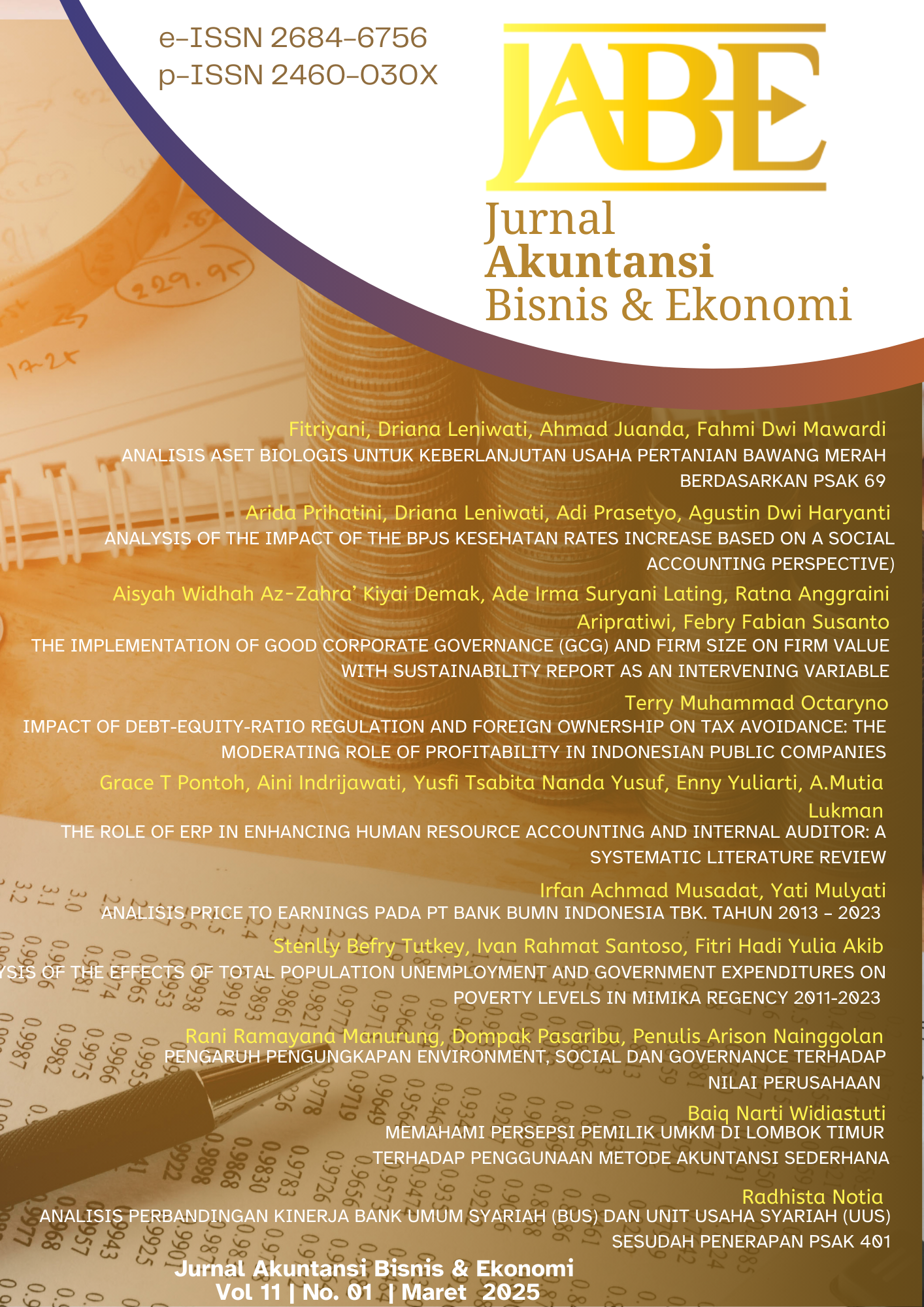The Role of ERP in Enhancing Human Resource Accounting and Internal Auditor: A Systematic Literature Review
DOI:
https://doi.org/10.33197/jabe.vol11.iss1.2025.2359Keywords:
Enterprise Resource Planning, Human Resource Accounting, Internal auditor, systematic literature reviewAbstract
The role of ERP systems in the fields of Human Resource Accounting (HRA) and Internal Auditing is increasingly crucial in the era of digitization and the demand for company efficiency. The implementation of ERP systems in HRA can provide benefits in measuring the costs and value of employees and assist management in making strategic decisions. On the other hand, in the context of Internal Auditing, ERP becomes an essential tool that can support the performance of internal auditors in obtaining the data and information needed to carry out audit tasks. This article review is conducted using a systematic literature review, resulting in 37 published articles identified through five stages. From the 37 articles, three journals each discussing the role of ERP in HRA and the role of ERP in internal auditing were obtained. This indicates that discussions related to the role of ERP in HRA and the role of ERP in internal auditing are still relatively low compared to the role of ERP in HRM. Additionally, there is a gap in the reviewed articles between HRA and internal auditing. Fifteen articles were obtained for HRA and eight articles for internal auditing. This creates an information imbalance for readers. This article review does not focus on ERP systems or modules but rather on the roles or outcomes of ERP systems that assist human resource accounting and internal auditors respectively in carrying out their duties and responsibilities in the company.
Downloads
References
Abderraouf, G. (2020). Measuring Human Resources’ Value using Human Resources Accounting Methods and Models - Theoretical Study-. El-Wahat Journal for Research and Studies, 13, 1–23.
Aires, M., & Abrantes, R. (2022). Requirements Elicitation in ERP Implementation Process. International Conference on Industry Sciences and Computer Science Innovation, 204, 794–802. https://doi.org/10.1016/j.procs.2022.08.096
Akintoye, I., Siyanbola, T., Adekunle, I., & Benjamin, R. (2018). Human Resources Accounting: A panacea for financial reporting problem. Research Journal of Finance and Accounting, 9(14), 25–41.
Akrong, G. B., Shao, Y., & Owusu, E. (2022). Evaluation of organizational climate factors on tax administration enterprise resource planning (ERP) system. Heliyon, 8(6), e09642. https://doi.org/10.1016/j.heliyon.2022.e09642
Al-Tahat, S. S., & Al-Zoubi, A. M. (2020). The Challenges in Applying Human Resources Accounting in Auditing Companies (Field Study in Jordan). International Journal of Business and Social Science, 11(3). https://doi.org/10.30845/ijbss.v11n3a21
Alaskari, O., Pinedo-Cuenca, R., & Ahmad, M. M. (2021). Framework for implementation of enterprise resource planning (ERP) systems in small and medium enterprises (SMEs): A case study. 30th International Conference on Flexible Automation and Intelligent Manufacturing (FAIM2021) 07-10 September 2021, Athens, Greece., 55(C), 424–430. https://doi.org/10.1016/j.promfg.2021.10.058
Alhalboosi, F. H. A., Al-halboosi, I. A. M., & Mawlood, S. J. (2021). Role of ERP Systems in Improving Human Resources Management Processes. Review of International Geographical Education Online, 11(4), 1667–1681. https://doi.org/10.33403/rigeo.8006876
Aljarrah, M. (2021). The Impact of Enterprise Resource Planning System of Human Resources on the Employees ’ Performance Appraisal in Jordan 2 Literature Review. WSEAS Transaction on Environment and Development, 17, 351–359. https://doi.org/10.37394/232015.2021.17.35
Alsharari, N. M. (2022). The Implementation of Enterprise Resource Planning (ERP) in The United Arab Emirates: A Case of Musanada Corporation. International Journal of Technology, Innovation and Management (IJTIM), 2(1), 1–22.
Alsurayyi, A. I., & Alsughayer, S. A. (2021). The Relationship between Corporate Governance and Firm Performance: The Effect of Internal Audit and Enterprise Resource Planning (ERP). Open Journal of Accounting, 10(02), 56–76. https://doi.org/10.4236/ojacct.2021.102006
Asfahani, A. M. (2021). The Complementary Relationship between Human Resources Accounting and Human Resources Information System. Open Journal of Accounting, 10(02), 30–41. https://doi.org/10.4236/ojacct.2021.102004
Barros, C., & Marques, R. P. (2022). Continuous Assurance for the Digital Transformation of Internal Auditing. Journal of Information Systems Engineering and Management, 7(1). https://doi.org/10.55267/iadt.07.11681
Bender, B., Bertheau, C., & Gronau, N. (2021). Future ERP Systems: A Research Agenda. 23rd International Conference on Enterprise Information Systems, ICEIS - Proceedings, 2(Iceis), 776–783. https://doi.org/10.5220/0010477307760783
Chima, C. C. (2022). Artificial Intelligence in Human Resources Management and Human Resource Accounting in Nigerian Public Sector. Management and Human Resource Research Journal, 11(01), 3363–7036.
Daddau, H., Yahya, S. A., Junaidu, H. S., & ... (2020). Human Resources Accounting and Theories. Kaduna Journal of Postgraduate Research, 3(1), 46–57. https://www.journal.kasu.edu.ng/index.php/kjpr/article/view/556
Dalveren, Y. (2014). Using E-learning in Enterprise Resource Planning (ERP) Training: A Case Study to Assist Curriculum Designers in Turkey. Procedia - Social and Behavioral Sciences, 116, 1353–1357. https://doi.org/10.1016/j.sbspro.2014.01.396
Daniela, P., & Attila, T. (2013). Internal Audit versus Internal Control and Coaching. International Economic Conference of Sibiu 2013 Post Crisis Economy: Challenges and Opportunities, IECS 2013, 6(13), 694–702. https://doi.org/10.1016/s2212-5671(13)00191-3
Denyer, D., & Tranfield, D. (2009). Producing a Systematic Review. In The SAGE Handbook of Organizational Research Methods (pp. 671–689).
Dong, L. (2015). Analysis on the Application of Human Resources Accounting in Enterprise Human Resources Management. International Conference on Management Science, Education Technology, Arts, Social Science and Economics, Msetasse, 610–614. https://doi.org/10.2991/msetasse-15.2015.134
Enofe, a O., Mgbame, C., Otuya, S., & Ovie, C. (2013). Human Resources Accounting Disclosures in Nigeria Quoted Firms. Research of Finance and Accounting, 4(13), 7–13.
Farhangnia, Z., Naji, A., Kamali, M., & Zahra Ramzani4, Shaghayegh Maleki5, A. A. (2021). Human Resources Accounting in Iran. International Journal of Social Science and Human Research, 04(11), 3404–3413. https://doi.org/10.47191/ijsshr/v4-i11-50
Habiburrochman, & Irawati, A. S. D. (2021). The Measurements of Human Resources Accounting: The Applications and Challenges in Facing the Industrial Revolution 4.0. Review of International Geographical Education Online, 11(4), 430–445. https://doi.org/10.33403/rigeo.800659
Haddad, N. E. (2014). Human Resources Accounting: Accounting for the Most Important Resource of the Enterprise. International Journal of Arts and Commerce, 3(8), 1–16.
Hanskamp-Sebregts, M., Robben, P. B., Wollersheim, H., & Zegers, M. (2020). Transparency about internal audit results to reduce the supervisory burden: A qualitative study on the preconditions of sharing audit results. Health Policy, 124(2), 216–223. https://doi.org/10.1016/j.healthpol.2019.11.013
Hietala, H., & Paivarinta, T. (2021). Benefits realisation in post-implementation development of ERP systems: A case study. CENTERIS - International Conference on Enterprise Information Systems / Projman - International Conference on Project Management / Hcist - International Conference on Health and Social Care Information Systems and Technologies 2020, 181(2020), 419–426. https://doi.org/10.1016/j.procs.2021.01.186
Huang, F., No, W. G., Vasarhelyi, M. A., & Yan, Z. (2022). Audit data analytics, machine learning, and full population testing. Journal of Finance and Data Science, 8, 138–144. https://doi.org/10.1016/j.jfds.2022.05.002
Hustad, E., & Stensholt, J. (2023). Customizing ERP-systems: A framework to support the decision-making process. Procedia Computer Science, 219, 789–796. https://doi.org/10.1016/j.procs.2023.01.352
Islam, A. M., Kamruzzaman, M., & Redwanuzzaman, M. (2013). Human Resource Accounting: Recognition and Disclosure of Accounting Methods & Techniques. Global Journal of Management and Business Research Accounting and Auditing, 13(3), 1–10.
Jacob, J., & Farouq, S. (2013). A Review of Human Resource Accounting and Organizational Performance. International Journal of Economics and Finance, 5(8), 74–83. https://doi.org/10.5539/ijef.v5n8p74
Kai, R., Yusheng, K., Ntarmah, A. H., & Ti, C. (2022). Constructing internal audit quality evaluation index: evidence from listed companies in Jiangsu province, China. Heliyon, 8(9), e10598. https://doi.org/10.1016/j.heliyon.2022.e10598
Korol, V., Dmytryk, O., Karpenko, O., Riadinska, V., Basiuk, O., Kobylnik, D., Moroz, V., Safronova, O., Alisov, E., & Mishchenko, T. (2022). Elaboration of Recommendations on the Development of the State Internal Audit System When Applying the Digital Technologies. Eastern-European Journal of Enterprise Technologies, 1(13–115), 39–48. https://doi.org/10.15587/1729-4061.2022.252424
Kumar, V., Ramachandran, D., & Kumar, B. (2021). Influence of new-age technologies on marketing: A research agenda. Journal of Business Research, 125(January), 864–877. https://doi.org/10.1016/j.jbusres.2020.01.007
Lee, J., & Seo, H. (2021). A Study on the API Gateway for human resources management modules extensions in ERP. Journal of The Korea Society of Computer and Information, 26(2), 79–88.
Lucan, A. N. C., Hlaciuc, E., & Zaiceanu, A. M. (2015). The Impact and Results of the Internal Audit Activity Exercised in the Public Sector in Romania. Procedia Economics and Finance, 32(15), 394–399. https://doi.org/10.1016/s2212-5671(15)01409-4
Martins, E. J., & Belfo, F. P. (2022). Major concerns about Enterprise Resource Planning (ERP) systems: A systematic review of a decade of research (2011-2021). CENTERIS – International Conference on Enterprise Information Systems / Projman – International Conference on Project Management / HCIST – International Conference on Health and Social Care Information Systems and Technologies 2022, 219, 378–387. https://doi.org/10.1016/j.procs.2023.01.303
Matende, S., & Ogao, P. (2013). Enterprise Resource Planning (ERP) System Implementation: A Case for User Participation. CENTERIS 2013 - Conference on Enterprise Information Systems / PRojman 2013 - International Conference on Project Management / HCIST 2013 - International Conference on Health and Social Care Information Systems and Technologies, 9, 518–526. https://doi.org/10.1016/j.protcy.2013.12.058
Molina-Castillo, F.-J., Rodríguez, R., López-Nicolas, C., & Bouwman, H. (2022). The role of ERP in business model innovation: Impetus or impediment. Digital Business, 2(2), 100024. https://doi.org/10.1016/j.digbus.2022.100024
Nordin, I. G. (2022). Narratives of internal audit: The Sisyphean work of becoming “independent.” Critical Perspectives on Accounting, March, 102448. https://doi.org/10.1016/j.cpa.2022.102448
Ogenyi, M. A., & Oladele, K. O. (2015). Human resources accounting (HRA) in Nigeria: An analysis of challenges. Research Journal of Finance and Accounting, 6(22), 15–20. http://www.iiste.org
Oluwatoyin, A. S. (2014). Human resources accounting and disclosure in financial statement: Literature review. Research Journal of Finance and Accounting, 5(22), 64–76.
Osanyinbi, T. G., & Oyekanmi, A. O. (2018). Human Resource Accounting and Management. Proceedings of the 7th Annual International Academic Conference on Accounting and Finance Disruptive Technology: Accounting Practices, Financial and Sustainability Reporting.
Peng, Z. (2019). Discussion on Basic Theory , Recognition and Measurement of Human Resources Accounting. International Conference on Humanities, Management Engineering and Education Technology, Hmeet, 129–134.
Downloads
Published
How to Cite
Issue
Section
License
Copyright (c) 2025 Yusfi Tsabita Nanda Yusuf, Aini Indrijawati, Yusfi Tsabita, Enny Yuliarti, Mutia Lukman

This work is licensed under a Creative Commons Attribution-NonCommercial-ShareAlike 4.0 International License.
Submission of a manuscript implies that the submitted work has not been published before (except as part of a thesis or report, or abstract); that it is not under consideration for publication elsewhere; that its publication has been approved by all co-authors. If and when the manuscript is accepted for publication, the author(s) still hold the copyright and retain publishing rights without restrictions. Authors or others are allowed to multiply the article as long as not for commercial purposes. For the new invention, authors are suggested to manage its patent before published. The license type is CC-BY-SA 4.0.












